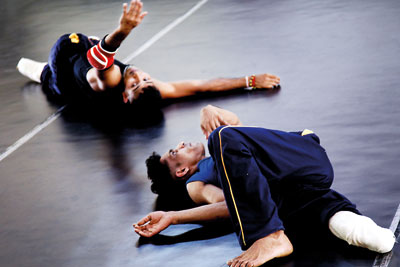The two legs lean forlornly against the steps. Their owners are several feet away, dancing. Strong bodies contort gracefully, bending and straightening, perfectly balanced on one foot. No attempt is made to mask their loss, where the knee ends abruptly in a stump. We are at the rehearsals for ChangeAble Cohesion, directed by Gerda König and Gustavo Fijalkow of the German DIN A 13 Tanzcompany.
The group pride themselves on being one of the few genuinely mixed-able dance companies around. They’ve spent the last two months in Sri Lanka collaborating with six local dancers to create a piece that is to be admired for the way the choreography treats abled and disabled dancers with equal admiration and respect.
Gerda König makes for an unusual choreographer because she isn’t a dancer herself. A case of muscular dystrophy has left her wheelchair bound but Gerda (who founded the company in 1995) can use words alone to detail entire sequences of movement. She says she and her long-time assistant choreographer Marc Stulhmann share a deep understanding, and a few sentences is all she needs to convey her wishes to him. As for the dancers, her degree in psychology shapes her interactions with them. Explaining that their work is deeply personal, she says “I see also their personality and I try to bring that into the piece.” Later she adds: “We are all creating it together.”
Gerda’s approach is to give people ideas and images and then to ask them to translate this through their bodies, says Gustavo, who has worked with Gerda since 2005. The two have travelled the world, engaging with local artists and audiences in Brazil, Ethiopia, Ghana, Kenya, Senegal and South Africa as well as performing in international dance festivals in the US, UK, Sweden and Poland. Their biannual Crossings Dance Festival for mixed abled dance companies is the first of its kind in Germany.
It’s clear that it’s a process fraught with complications – in Sri Lanka they’ve had to surmount a language barrier says Gustavo, adding that finding professional dancers has been a challenge in itself. With the help of the Sunera Foundation, Sri Lankan pioneers in mixed able performances, they were able to connect with an army medical rehabilitation centre where they found their dancers. They also needed to ensure that their dancers were willing to commit to a long gestation period and a gruelling schedule of 9 -5, five days a week. One of the show’s most dramatic sequences would leave dancers with scraped and bloodied knees and elbows, but the piece was worth the pain.
At one point in performance, the six dancers – Suranga Bopititya, Venuri Perera, Saman Pushpakumara, Nadeeka Tharangani, Mahesh Umagiliya and Thusitha Wimalasuriya - enter on the diagonal. They move in staccato and they’re perfectly synchronised. Staying close to the floor, they flow from one tableau into the other – juxtaposing limbs, they create strange new geometries and discover odd, exhilarating new movements. One is startled into seeing the human form afresh. I understand now what Gerda meant when she spoke of how different bodies gave her different ideas for her choreography.
The performance was crammed full of meaning, almost to a fault. It felt burdened with emotion as dancers struggled in the abstract with outpourings of violence, death, despair and discrimination. One sequence toward the end united the dancers in a series of peaceful, harmonious movements, until one of them seemed to become stuck, to come undone. Powerful and disturbing, Venuri Perera’s performance was among the show’s more memorable sequences.
Almost without exception, all six performers did beautifully as each was given the space to express themselves. It’s reflective of Gerda’s determination that disabled and abled dancers be equals on stage. It’s an extension of her approach during rehearsals. “I’m hard with everybody. It’s never that I’m softer because someone is disabled, it’s the other way around.”
The final show was not without its own problems – it would have been improved by some editing and audiences were unable to see the performers clearly for the lack of an elevated stage. The costumes and video too could have been much improved upon. Hopefully, these issues will be addressed before the show is staged in Germany later this year. Subsequent projects in Venezuela and Lebanon are scheduled, with the Sri Lankan performers reuniting for a combined show in Germany in 2014.
For Gerda and her team, this has been an interesting experience, not least because it’s their first time in Asia. “I’m inspired when I am in another country,” she says, explaining that being confronted with the unfamiliar helped inspire her to create new performances. It seems to be an approach that pays rich dividends. |


